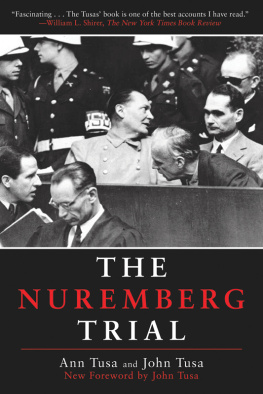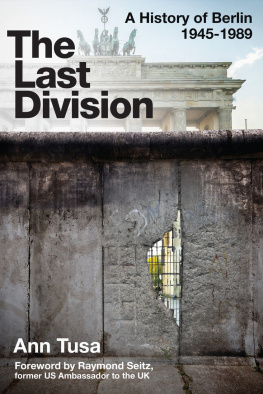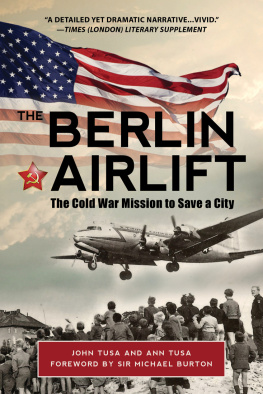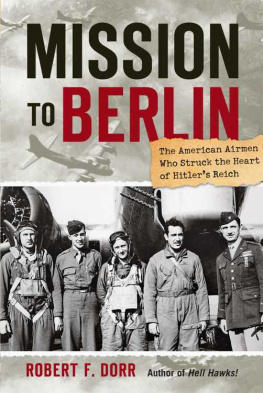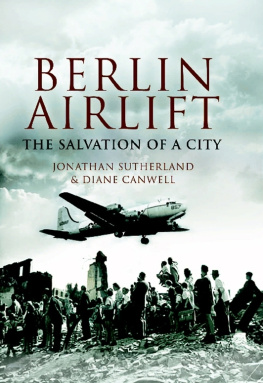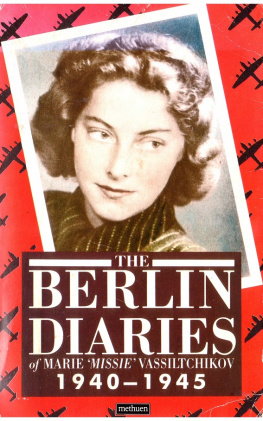

Also by Ann and John Tusa
THE NUREMBERG TRIAL
and
by Ann Tusa
THE LAST DIVISION A HISTORY OF BERLIN 19451989

Copyright 2019 by Ann Tusa and John Tusa
Foreword 2019 Sir Michael Burton
Originally published 1988 by Hodder & Stoughton, Ltd.
Published in the UK 1998 by Spellmount Limited.
All rights reserved. No part of this book may be reproduced in any manner without the express written consent of the publisher, except in the case of brief excerpts in critical reviews or articles. All inquiries should be addressed to Skyhorse Publishing, 307 West 36th Street, 11th Floor, New York, NY 10018.
Skyhorse Publishing books may be purchased in bulk at special discounts for sales promotion, corporate gifts, fund-raising, or educational purposes. Special editions can also be created to specifications. For details, contact the Special Sales Department, Skyhorse Publishing, 307 West 36th Street, 11th Floor, New York, NY 10018 or .
Skyhorse and Skyhorse Publishing are registered trademarks of Skyhorse Publishing, Inc., a Delaware corporation.
Visit our website at www.skyhorsepublishing.com.
10 9 8 7 6 5 4 3 2 1
Library of Congress Cataloging-in-Publication Data is available on file.
Cover design by Qualcomm
Cover photo credit AP
ISBN: 978-1-5107-4061-7
Ebook ISBN: 978-1-5107-4062-4
Printed in the United States of America
Contents
List of Plates
All photographs courtesy of Landesbildstelle


Foreword
Sir Michael Burton
When I was the British Minister and Deputy Commandant in Berlin during the last five years of the post-war Four Power occcupation of the city, which ended with its reunification in 1990, the memory of the blockade and airlift of 1948/49 was still very much alive. The three Western Alliesthe US, Britain, and Francegathered every year, together with the leaders of West Berlin, to place wreaths at the memorial outside Tempelhof, the former US military airport. The memorial takes the form of a broken arch, symbolizing the beginning of a bridge (the German term for the airlift is the rather more graphic Luftbrcke or Airbridge). The corresponding western arch is at Frankfurt International Airport. At the wreath-laying ceremony, we were remembering those who lost their lives keeping West Berlin supplied with basic foodstuffs, medical supplies, and fuel during those fateful fifteen months. Although the airlift was US-led, it so happens that the largest number of names recorded is British, largely due to a single aircraft crash.
The background to these events, as graphically told in Ann and John Tusas superbly researched book, is that the four victorious Powers of World War IIthe three Western Allies plus the Soviet Unionagreed at the Potsdam Conference at the conclusion of the war that, in addition to defeated Nazi Germany being divided into four zones of occupation, Berlin would be divided into four Allied sectors. The problem was that, as the three Western Allies became painfully aware when they moved their troops up to garrison these Sectors, Berlin was squarely in the middle of the Soviet Zone, closer to the Polish border than to the inner German border. The Potsdam Agreement provided for three air corridors with guaranteed access to Berlin from the Western Allies Zones in the west. But there was no corresponding agreement on guaranteed road and water access to the city.
This distinction became of critical importance when the Soviet Union imposed a blockade of Berlin in 1948. It was sparked by the Allied decision to introduce a new currency into their occupation zonesthe Deutschemarkin order to promote a revival of the shattered German economy. The Soviets, by contrast, favoured exacting maximum reprisals from that economy rather than helping it off its knees. When they closed off the access by road and waterways at the inner German border, the Allies were faced with a dilemma: whether to force supplies through along these routes and risk confrontation, and even war, with their erstwhile Soviet ally, or to supply the city along the legally guaranteed air corridors.
The dramatic story of what happened is recounted in this excellent book. The airlift produced many heroes, such as the citys mayor, Ernst Reuter, whose inspirational rhetoric called upon the world to look upon Berlins fight for freedom. Among the aircrew flying the planes carrying the suppliesof which there was more than one a minute landing at the RAF station at Gatow at the busiest timethere was, for example, US airman Gail Halvorson from Utah, who earned the undying gratitude of the Berliners by dropping sweets to the children.
But the main heroes were the ordinary people of the western sectors of the city who, in spite of their hunger, spurned the offer of improved rations if they moved to the Soviet sector, and decided to rely on the Allied airlift.
The fact that the airlift was bringing relief, not just to the Allied military garrisons but to the citys civilian population as well, was a critical factor. Not only did it make Stalin realize that the blockade was failing to starve the city into submission, to induce the Allies to withdraw, and to turn the Berliners against them, it also changed the fundamental relationship between the Western Allies and the Berliners living in their sectors. Previously, it had been that of occupiers to occupied. After the blockade ended, it became more like a partnership, in the cause of keeping West Berlin free and democratic. And in time it evolved into feelings of genuine friendship on both side.
On October 2, 1990, the day before the solemn reunification of divided Germany and Berlin, the Allied authorities in the city (of whom I was one) met for the last time and wrote a letter to the Berlin House of Representatives. The commitment of our three countries to Berlin, they wrote, was based on a conviction that freedom, democracy, and self-determination must be upheld wherever and whenever they are threatened and whatever the cost. Today the world looks on Berlin and sees a triumph of freedom and the human spirit.
The epic events of the Berlin airlift made a major contribution to this happy result.
Sir Michael Burton
Introduction
On 31 March 1948 General Lucius D. Clay, the Military Governor of the American zone of occupation in Germany, sent a telegram from Berlin to General Omar Bradley, Chief of Staff of the US Army in Washington:
Have received a peremptory letter from Soviet Deputy Commander requiring on 24 hours notice that our military and civilian employees proceeding thru Soviet Zone to Berlin will submit to individual documentation and also will submit their personal belongings for Soviet inspection.
Likewise a permit is required from Soviet Commander for all freight brought into Berlin by military trains for the use of our occupation forces.
Obviously these conditions would make impossible travel between Berlin and our zone by American personnel except by air. Moreover, it is undoubtedly the first of a series of restrictive measures designed to drive us from Berlin.
Next page

